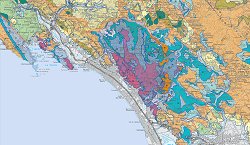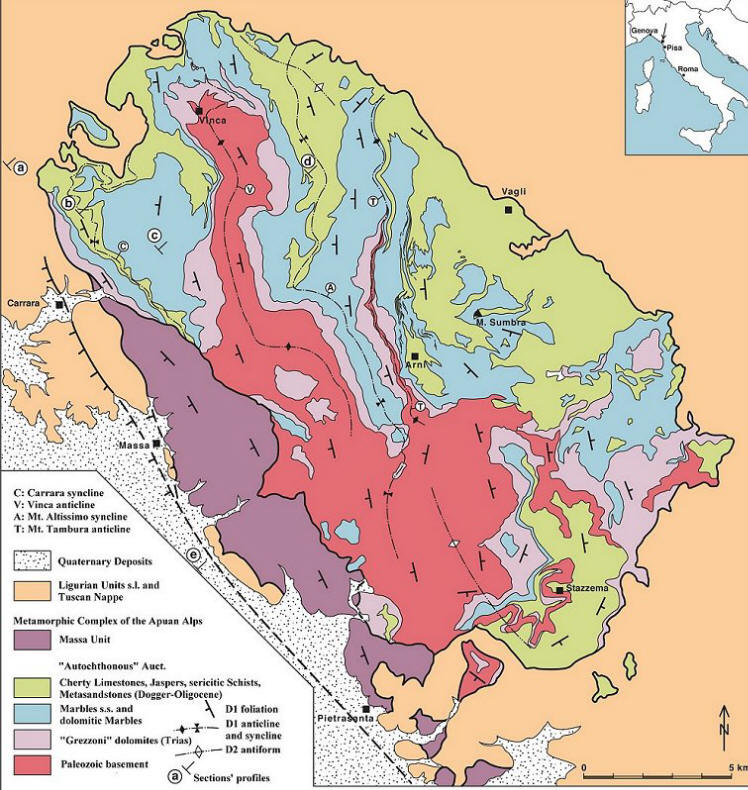|
|
Geology
Apuan Alps interpretation
|
|


 |
The current interpretation model
of the Apuan Alps was defined in 1990 when Carmignani and Kligfield (and,
separately, Coli) noted closes analogies between the evolution of the Apuan-Apennine
area and northern American Core Complex, where more recent structures
of extensional tectonics superimposed upon older compressive deformations.
Nowadays, almost the
entire scientific community agrees on the interpretation of the Apuan Alps
and the Northern Apennines as the complex result of two different and
subsequent deformation phases: the first compressional-collisional and the
second extensional.
|

|
|
|
The
Apuan Alps and the Northern Apennines belong to the same thrust and
fold mountain belt originated during the Cenozoic by the overthrusting of
the Ligurian Units, derived from the ocean (Alpine Tethys) internal domain,
onto the external Tuscan and Umbria-Marche continental margin
domains.
|
|
|

Tectonic map of the Northern Apennines (Carmignani
et al.,
2006) |
The
complex tectonic evolution of the area showed a first phase of
deformation and metamorphism within a collisional geodynamic context. It was then
followed by a second phase within an extensional tectonic regime,
characterized by the development of low-angle shear zones and normal faults
responsible for the uplift and exhumation of the deepest structural units.
In the light of crustal
plate movements in the Mediterranean area, the tectonic events began in the
Late Cretaceous when the European and Apulian (-African) continental margins
sutured the Tethys Ocean. In particular, during the Late Oligocene, the
Briançonnais microcontinent (before belonging to the European plate) moved
towards East and collided with the Adria microplate with the subduction of
the Apulian lithosphere underneath the Corsica-Sardinia block.
Thus, the Apuan Alps and the Northern Apennines underwent a first phase of
structuration during a compressional tectonic phase characterized by crustal
shortening and nappe emplacement towards the Apulian foreland. Since the
Tortonian onwards, the subduction process contributed to the development of
back-arc oceanic basins and therefore the opening of the Thyrrenian Sea,
within crustal extensional processes which are clearly recognizable in the
extensional features of macro and microstructures.
A large tectonic window
formed in the Apuan Alps, thus exposing the ‘Metamorphic Complex of the
Apuan Alps’. It is the deepest structural level outcropping in the internal
parts of the Northern Apennines and it is therefore a key area to understand
mechanisms and geodynamic processes which led to the formation of the
Apenninic range.
|
|
|
In particular, two
superposed units, both belonging to the metamorphic succession of the Tuscan
Domain, are identifiable in the Apuan tectonic window. The lower unit is the
"Autochthonous" Auct. with extensive outcrops across the main ridge, both on
the coastal and inland mountainsides, whereas the Massa Unit, on top of it,
is only found in the westernmost part of the tectonic window.
The Massa Unit is
composed of a Paleozoic basement on which lays in unconformity a thick
Triassic sedimentary sequence characterized by Ladinian basic metavolcanic
rocks. The Mesozoic cover begins with quartz metaconglomerates associated
with metasandstones, metasiltstones and black phyllites which can be
interpreted as continental and/or coastal siliciclastic deposits. Upward,
they are followed by mainly calcareous rocks (marbles, metabreccias,
calcareous schists and carbonate phyllites), deriving from carbonate shelf
and neritic-pelagic deposits, intercalated with alkaline metabasites. The
sequence ended with Carnian phyllites of continental-coastal origin and
levels of anagenites: metaconglomerates with mainly quartz and quartzite
clasts.
|
|
|
The "Autochthonous"
Auct. too is formed by a Paleozoic basement, deriving from
previous orogenic structures, with an initial age presumably dating
back to the Cambrian. A metasedimentary sequence, showing ages from
the Late Triassic up to the Oligocene, unconformably lies upon the
crystalline basement, like in the Massa Unit.
The
Meso-Cenozoic cover begins with a classic “Verrucano” characterized
by polygenic conglomerates, calcareous metasandstones and
siliciclastic dolomites intercalated with metabreccias (VIN) presumably
deriving from a transitional (from continental to littoral)
depositional environment. They are followed by the “Grezzoni”
dolomites (GRE) of the Late Triassic carbonate shelf, which are followed
by micritic fossiliferous metalimestones of the “Colonnata” limestones and marlstones.
They are then followed
by the Megalodont-bearing Marbles (MMG) intercalated with polygenic metabreccias
(BSE) and chloritoid schists
(BSEa) which testify episodes of
emersion of the carbonate platform with the formation of lateritic-bauxitic
layers and the deposition of debris flows at the bottom of the
tectonically active scarps.
Marbles with different dolomitization levels, crystalline dolomites,
marbles and monogenic metabreccias are typical of the overlying
formations of Dolomitic marbles (MDD) and Marbles s.s.
(MAA), witnessing to the
development of a new carbonate platform formed after that of the
“Grezzoni” dolomites in the Late Triassic. Upward, pinkish marbles (MRZ), metalimestones with cherts
(CLF), calcschists
(CCI) and
jaspers (DSD) are a sign of
the drowning of the marble carbonate platform and the beginning of
an hemipelagic sedimentation.
Possible time
displacement among the different subsiding blocks brought about the
formation of very different depositional environments with “reduced”
and/or “condensed” sequences, the first evidence of which is
polygenic metabreccias characterized by a phyllitic matrix. The
sequence ends with metalimestones with cherty bands and nodules (ENT), calcschists, Nummulite limestones, sericitic phyllites
(SSR) and quartz-feldspatic
metasandstones (PSM) belonging respectively to pelagic and foredeep
deposits reaching the Late Oligocene.
In conclusion,
there is a strong correlation between the rocks of the Paleozoic
basement of the Massa Unit and those of the "Autochthonous" Auct.
which show analogous deformation and a similar greenschist facies
metamorphism owing to the Hercynian orogeny. The same situation
repeats when comparing the two metasedimentary covers because,
despite the first being less thick than the second, their rocks are
characterized by the same Alpine metamorphism, whose greenschist
facies paragenesis shows differences in temperature and pressure
conditions, higher in the Massa Unit.
In the proposed Geopark territory, rocks of the non-Metamorphic
Succession of Tuscan Domain outcrop beyond the borders of the
tectonic window. They are related to a single unit, commonly known
as Tuscan Nappe geometrically overlying the Metamorphic Complex of
the Apuan Alps (made up by the Massa Unit and the "Autochthonous"
Auct.). The Tuscan Nappe rocks belong to the Meso-Cenozoic
cover, the Paleozoic basement not being present at all. There are
closed and frequent correlations as regards lithology, depositional
environment and age between the geological formations of
"Autochthonous" Auct. and Tuscan Nappe. The main difference
lays in the degree of metamorphism which is absent or very weak in
the Tuscan Nappe.
The Tuscan Nappe is in
turn overthrusted by the Ligurian Units s.l., which crop out mainly
in the northern part of the Geopark area, being represented by Helminthoid
Flysch (Late Cretaceous) with basal complex characterized by ophiolitic
detritism and olistolites and by shaly-calcereous deposits and calcareous
turdidites ranging in age from Late Cretaceous to Eocene.
The proposed territory is also characterized by post-orogenic deposits which
cover the whole time frame from the Late Miocene to today. This is
particularly the case of polygenic Breccias of Metato (which derived from
formations of the Tuscan Domaine cover), glacial and fluvio-glacial deposits
(Middle-Late Pleistocene) as well as alluvial, slope and landslide deposits
(Holocene). |

Stratigraphic column
of the
"Autochthonous"
Auct.(Carmignani et al.,
2006)
|
|
|
The detailed description of the formations above mentioned is here omitted,
referring to the legend of the enclosed geological map.
The complex geological history of the Apuan Alps is responsible for the
great geodiversity of rocks and minerals of the territory. The composition
of lithotypes, the Hercynian and Alpine deformations, metamorphism and
hydrothermalism brought about a remarkable variety of minerals. Witness the
large number of minerals found in the area, achieving the total of about
275.
For the first time
30 mineral species have been discovered and described in the Apuan Alps [allanite-(La),
apuanite, bottinoite, carraraite, dessauite, garavellite, grumiplucite,
marrucciite, meneghinite, moëloite, pellouxite, pillaite, rouxelite,
scainiite, versiliaite, volaschioite, zaccagnaite,
zincalstibite, etc.] most of which are exclusive to this area.
|
|
|

Tectonic map of the Apuan Alps (Carmignani
et al.,
2006)
|
|
|